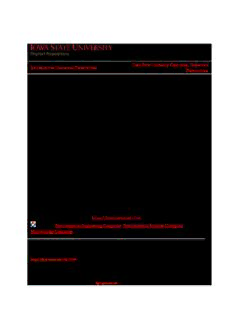
Laboratory studies on the temperature-phased anaerobic digestion of mixtures of primary and PDF
Preview Laboratory studies on the temperature-phased anaerobic digestion of mixtures of primary and
Iowa State University Capstones, Theses and Retrospective Theses and Dissertations Dissertations 1997 Laboratory studies on the temperature-phased anaerobic digestion of mixtures of primary and waste activated sludge Yue Han Iowa State University Follow this and additional works at:https://lib.dr.iastate.edu/rtd Part of theEnvironmental Engineering Commons,Environmental Sciences Commons, and the Microbiology Commons Recommended Citation Han, Yue, "Laboratory studies on the temperature-phased anaerobic digestion of mixtures of primary and waste activated sludge " (1997).Retrospective Theses and Dissertations. 12204. https://lib.dr.iastate.edu/rtd/12204 This Dissertation is brought to you for free and open access by the Iowa State University Capstones, Theses and Dissertations at Iowa State University Digital Repository. It has been accepted for inclusion in Retrospective Theses and Dissertations by an authorized administrator of Iowa State University Digital Repository. For more information, please [email protected]. INFORMATION TO USERS This manuscript has been reproduced from the microfilm master. UMI films the text directly from the original or copy submitted. Thus, some thesis and dissertation copies are in typewriter &ce, i»Me others may be from any type of computer printer. The quality of this reproduction is dependent upon the quality of the copy submitted. Broken or indistinct print, colored or poor quality illustrations and photographs, print bleedthrough, substandard margins, and improper alignment can adversely affect reproductioiL In the unlikely event that the author did not send UMI a complete manuscript and there are missing pages, these will be noted. Also, if imauthorized copyright material had to be removed, a note will indicate the deletion. Oversize materials (e.g., nu^s, drawings, charts) are reproduced by sectioning the original, beginning at the upper left-hand comer and continuing from left to right in equal sections with small overiaps. Each original is also photographed in one exposure and is included in reduced form at the back of the book. Photographs included in the original manuscript have been reproduced xerographically in this copy. Higher quality 6" x 9" black and white photographic prints are available for any photographs or illustrations appearing in this copy for an additional charge. Contact UMI directly to order. UMI A Bell & Howell Infonnadon Compaiqr 300 Noith Zed) Road, Ann Aibor MI 48106-1346 USA 313/761-4700 800/521-0600 Laboratory studies on ttie temperature-phased anaerobic digestion of mixtures of primary and waste activated sludge by Yue Han A dissertation submitted to the graduate faculty in partial fulfillment of the requirements for the degree of DOCTOR OF PHILOSOPHY Major Civil Engineering (Environmental Engineering) Major Professor: Shihwu Sung Iowa State University Ames, Iowa 1997 Copyright © Yue Han, 1997. All rights reserved. DMI Number; 9737717 UMI Microform 9737717 Copyright 1997, by UMI Company. All rights reserved. This microform edition is protected against wiauthorized copying under Title 17, United States Code. UMI 300 North Zeeb Road Ann Arbor, MI 48103 ii Graduate College Iowa State University This is to certify that Doctoral dissertation of Yue Han has met the dissertation requirements of Iowa State University Signature was redacted for privacy. CoHimitlfee Member Signature was redacted for privacy. Committee^ember Signature was redacted for privacy. Committee Member Signature was redacted for privacy. ]!ommittee Member Signature was redacted for privacy. Major Professor Signature was redacted for privacy. For the Major Program Signature was redacted for privacy. For the Graduate College iii TABLE OF CONTENTS Page I. INTRODUCTION 1 Background 1 Rationale for the Application of Temperature-Phased Anaerobic Digestion 4 Objectives and Scope of Study 6 n. LITERATURE REVIEW 7 Microbiology and Biochemistry of Anaerobic Digestion 7 Functional Groups of Bacteria 7 Reactions in Anaerobic Digestion 10 Important Operational and Environmental Factors of Anaerobic Digestion 12 Operational Factors 13 Environmental Factors 16 Thermophilic Anaerobic Digestion 22 Development of Temperature-Phased Anaerobic Digestion 28 m. EXPERIMENTAL STUDY 30 Experimental Set-Up 30 Design and Dimension of Reactors 30 Reactor Configuration and Equipment 37 Experimental Procedure 40 Substrate 40 Reactor Start-Up 41 iv Operation of the System and Daily Maintenance 42 Experimental Testing 43 Total Solids (TS) and Total Volatile Solids (TVS) 43 Chemical Oxygen Demand (COD) 44 Coliform and Fecal Coliform Tests 45 Volatile Fatty Acids (VFA) 47 Alkalinity 49 pH 49 Biogas Composition Analysis 49 Experimental Plan 51 General Background 51 System Operation 51 VI. RESULTS AND DISCUSSION 53 Resuhs 53 VS Loading Rates at Different SRTs 53 Volatile Solids Removal 58 COD Removal 60 Coliform and Fecal Coliform Destruction 65 Methane Content and Daily Production Rate 81 pH, Volatile Fatty Acids, and Alkalinity 82 Discussion 93 V. CONCLUSIONS 96 V APPENDIX A; TIME PERIOD AND DAILY BIOGAS PRODUCTION DATA FOR 50:50 PS AND WAS 97 APPENDIX B: TIME PERIOD AND DAILY BIOGAS PRODUCTION DATA FOR 25:75 PS AND WAS 120 BIBLIOGRAPHY 136 ACKNOWLEDGMENTS 144 1 I. INTRODUCTION Background Anaerobic digestion has been used successfully for stabilizing wastewater sludges for over 70 years. Because of the emphasis on energy conservation and recovery and the desirability of obtaining beneficial use of wastewater sludge, anaerobic digestion has been and will continue to be the dominant sludge stabilization process. The primary objectives of anaerobic digestion are (1) reduce pathogens, (2) eliminate offensive odors, and (3) reduce organic matter and the potential for putrefaction. New federal regulations on wastewater sludge management were implemented in 1993 and will have an impact on virtually every biosolids disposal method, including application to agricultural land. The new regulations have restricted land use of sludge based on pathogen destruction criteria. According to the new standards for the disposal of sewage sludge [6], all Class A sludge must meet one of the following criteria at the time it is sold, given away, or used. Either • A fecal coliform density less than 1,000 Most Probable Number per gram of total solids (1,000 MPN/g IS). or • A Salmonella spp. Density less than 3 Most Probable Number per 4 grams of total solids (3 MPN/4g TS).
Description: